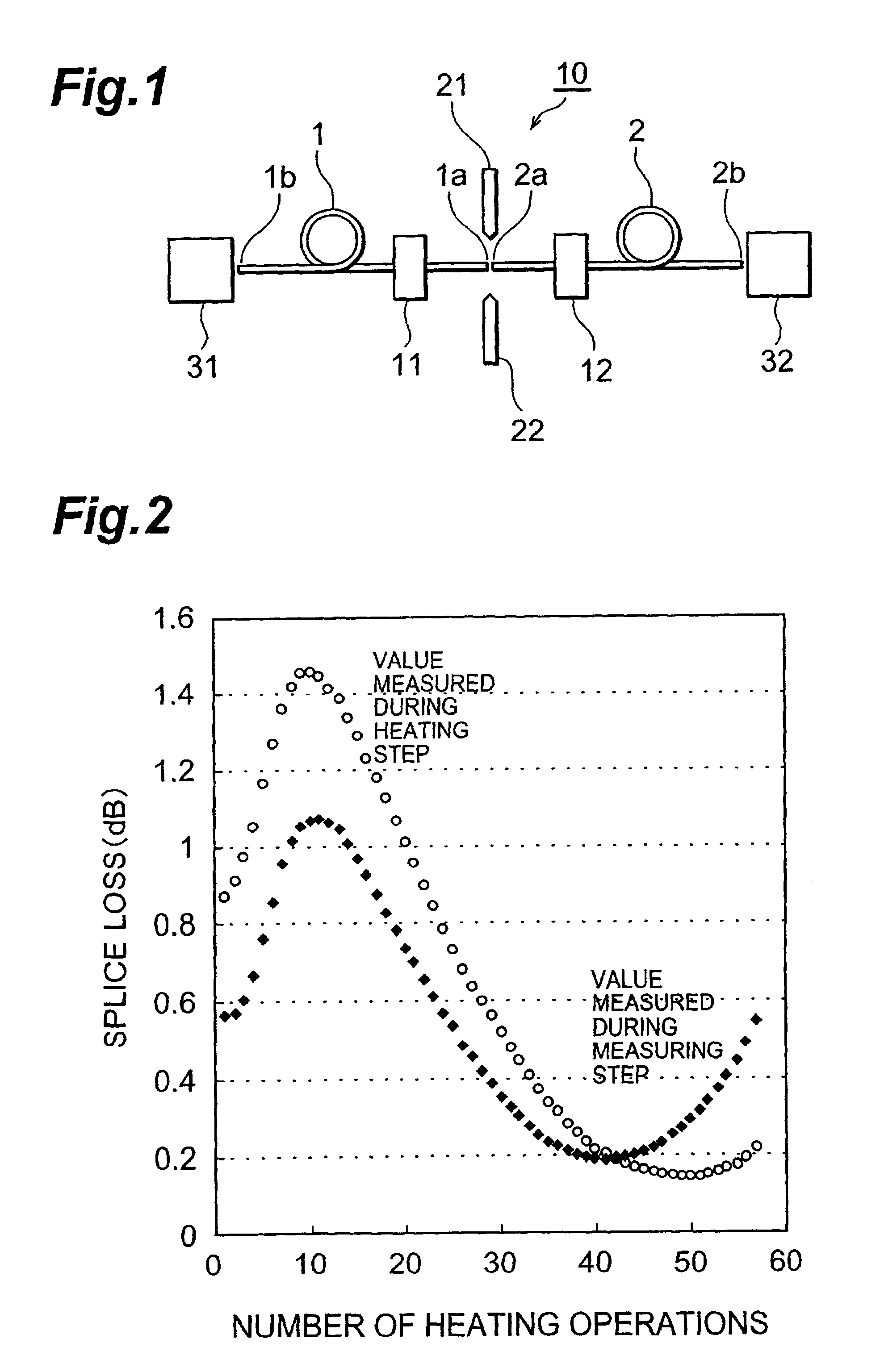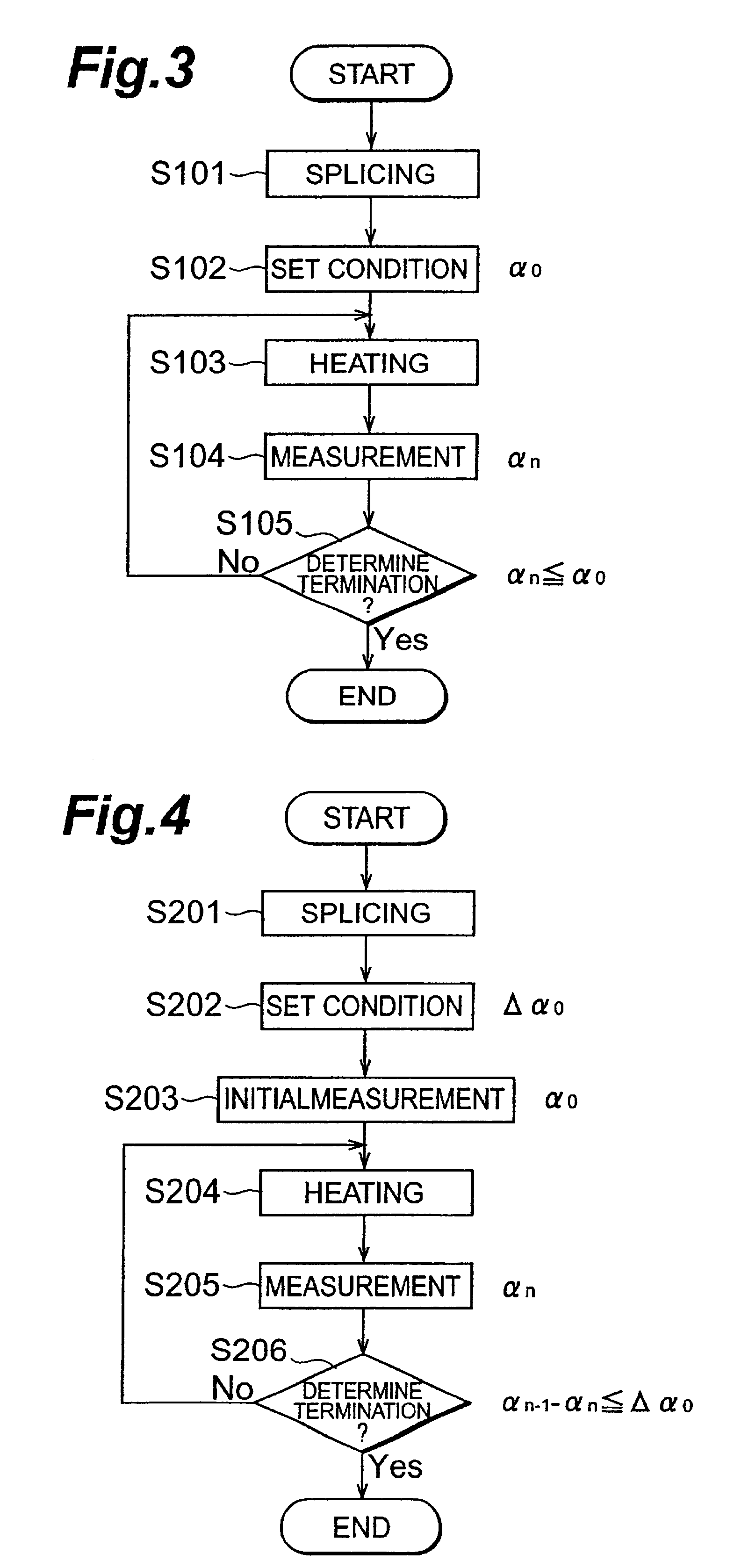Optical fiber splicing method and optical fiber
a technology of optical fiber and splicing method, which is applied in the direction of optical elements, manufacturing tools, instruments, etc., can solve the problems of insufficient splicing loss between splicing and splicing, inability to reduce splicing loss to a predetermined value, and difficulty in reducing splicing loss at room temperatur
- Summary
- Abstract
- Description
- Claims
- Application Information
AI Technical Summary
Benefits of technology
Problems solved by technology
Method used
Image
Examples
first embodiment
of the optical fiber splicing method in accordance with the first embodiment will now be explained. In this example, a single-mode optical fiber was used as the first optical fiber, whereas a dispersion-compensating optical fiber was used as the second optical fiber. Arc discharge was used in the splicing step, whereas the splice loss after the splicing step was 1.10 dB. A burner was used in the heating step, whereas a mixed gas composed of a propane gas (with a feed rate of 20 cc / min) and an oxygen gas (with a feed rate of 30 cc / min) was supplied to the burner. In each heating step, heating was carried out for 20 seconds. The time interval between one heating step and the next heating step was 10 seconds, during which the measuring step and termination determining step were carried out. The set value .alpha..sub.0 was 0.20 dB. The heating, measuring, and termination determining steps were repeatedly carried out until the measured splice loss .alpha..sub.n became the set value .alph...
second embodiment
A second embodiment of the optical fiber splicing method in accordance with the present invention will now be explained with reference to FIG. 4. The optical fiber splicing method in accordance with the second embodiment includes a splicing step (S201), a condition setting step (S202), an initial measurement step (S203), a heating step (S204), a measuring step (S205), and a termination determining step (S206).
The splicing step (S201) is similar to S101 in the first embodiment. In its subsequent condition setting step (S202), a set value .DELTA..alpha..sub.0 used in the termination determining step (S206), which will be carried out later, is set. In the initial measurement step (S203), the splice loss .alpha..sub.0 between the first and second optical fibers fused in the splicing step (S201) is measured. Thereafter, the heating step (S204), measuring step (S205), and termination determining step (S206) are carried out repeatedly.
In the termination determining step (S206), the differe...
specific example 2-1
of the optical fiber splicing method in accordance with the second embodiment will now be explained. The optical fiber, arc discharge, burner, mixed gas, each heating time, and times of the measuring and termination determining steps used in this example are the same as those in Example 1. The set value .DELTA..alpha..sub.0 was 0.01 dB. Then, the heating, measuring, and termination determining steps were repeated until the measured difference .DELTA..alpha..sub.n became the set value .DELTA..alpha..sub.0 or less. As a result, the measured difference .DELTA..alpha..sub.n became the set value .DELTA..alpha..sub.0 or less at the time when the number n of alternation reached 33, whereby the optical fiber connecting operation was terminated. The time required after terminating the condition setting step was 980 seconds. The finally obtained splice loss .alpha..sub.33 was 0.19 dB.
PUM
| Property | Measurement | Unit |
|---|---|---|
| temperature | aaaaa | aaaaa |
| temperature | aaaaa | aaaaa |
| temperature | aaaaa | aaaaa |
Abstract
Description
Claims
Application Information
 Login to View More
Login to View More - R&D
- Intellectual Property
- Life Sciences
- Materials
- Tech Scout
- Unparalleled Data Quality
- Higher Quality Content
- 60% Fewer Hallucinations
Browse by: Latest US Patents, China's latest patents, Technical Efficacy Thesaurus, Application Domain, Technology Topic, Popular Technical Reports.
© 2025 PatSnap. All rights reserved.Legal|Privacy policy|Modern Slavery Act Transparency Statement|Sitemap|About US| Contact US: help@patsnap.com



